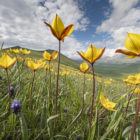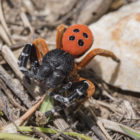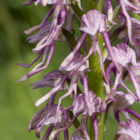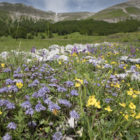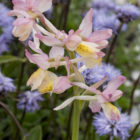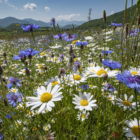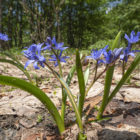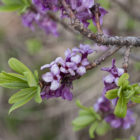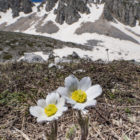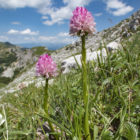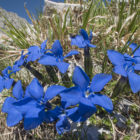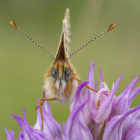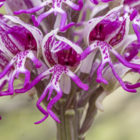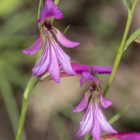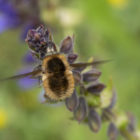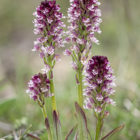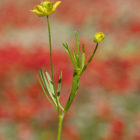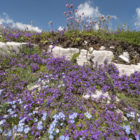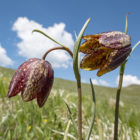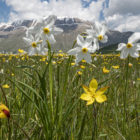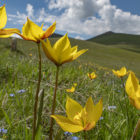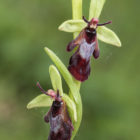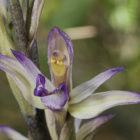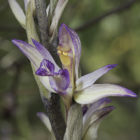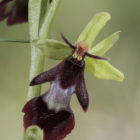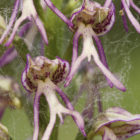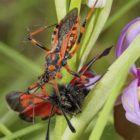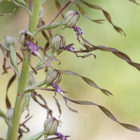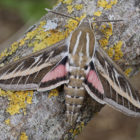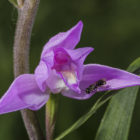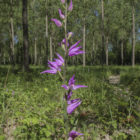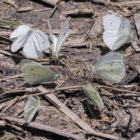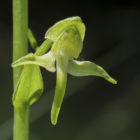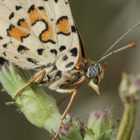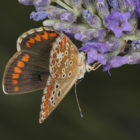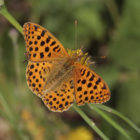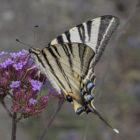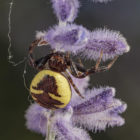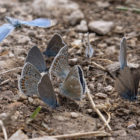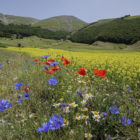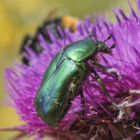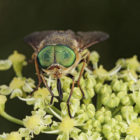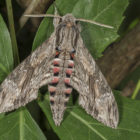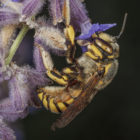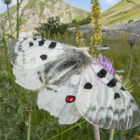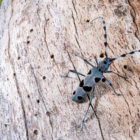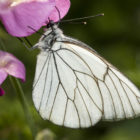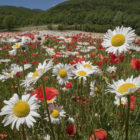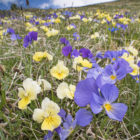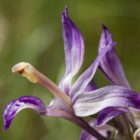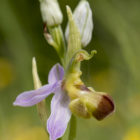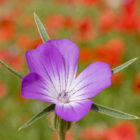Dates & Prices |
BOOK NOW |
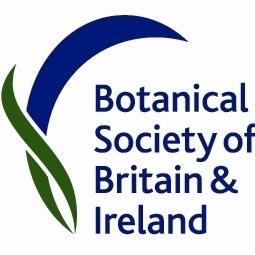 Dates: 17th – 24th May 2025 Confirmed departure
Dates: 17th – 24th May 2025 Confirmed departure
Price: £1,645 Full
Single Room Supplement: £175
Deposit: £150 per person
Price Includes: All meals, accommodation with private facilities, ground transport, services of guides, holiday report
Not Included: Flights, travel insurance, drinks and any other personal items.
Leader: Paul Harcourt Davies & Lois Ferguson
Group Size: Minimum of 4 and a maximum of 7 guests plus 2 leaders.
Grade: Gentle paced walks in a variety of terrains. Ideally suited to photography.
Holiday Highlights
- Enjoy a wealth of wildflowers, insects and birds with spectacular scenery in Sibillini National Park – an area of incredible biodiversity
- Exclusive high quality tour with a very small group specifically designed to increase each participants enjoyment of the holiday and to minimise the impact on the local sensitive environments where we visit
- Led by an elite team of Paul Harcourt Davies and Lois Ferguson, residents in Italy for 20+ years
- 3 centre tour staying in good hotels and pleasant & interesting locations
- Short drives for maximum time in the field
- Evening presentations on photography & environmental topics
Enjoy a week of wildlife in the wonderful Apennines with Paul Harcout Davies, on our first class tour of Sibillini!
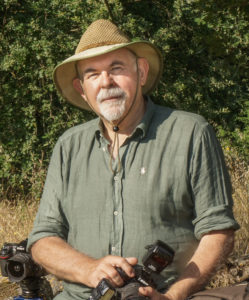
Paul Harcourt Davies is a professional photographer/author and conservationist with an international reputation gained through his images, his numerous books (19 to date), articles and lectures. He has led botanical, natural history and photographic trips for three decades and has lectured in the UK, USA, Cyprus (where he lived from 1978-81) and Italy on various aspects of photography and natural history, taught hundreds of workshops and is a prolific writer.
He is regarded as an authority on the Mediterranean flora and fauna (orchids in particular) and has been involved in numerous conservation projects. He was a founder member of the Hardy Orchid society, served as its chairman and is now an honorary Vice President: he was also chairman of Butterfly Conservation, S Wales. Paul has lived in Italy since 2003, where he is involved with numerous projects locally and nationally.
The Sibillini, a well kept secret, form a distinct part of the Apennine chain, that montane ‘backbone’ of Italy that stretches some 1200km (750 mi) down the length of the ‘boot’ from the Alps to the ‘toe’ and then beyond into Sicily. The Sibillini: an Italian Treasure House Mountain peaks are well below giants of the Alps (Gran Sasso, with Monte Cornu at 2910m (9554 ft) is the highest), ) but many lie above 2000m and are certainly high enough to support a rich alpine flora with interesting endemic species. Moreover, you can move in the matter of an hour or less from Mediterranean species at low altitudes to high alpines. There are numerous recognisable (and separately named) montane regions within the chain which are designated as National Parks such as Gran Sasso & Monti della Laga (148,935ha), Abruzzo (50,050ha) haunt of wolves and Marsican Bears) and the Sibillini (71,043ha) an area of incredible biodiversity. The Sibillini National Park is situated on the border of Umbria and Le Marche in central Italy and offers superb walking with a remarkable diversity of habitats making it a paradise for wildflowers, butterflies, birds and threatened species such as wolves and golden eagles. Our stay in the Sibillini embraces a wealth of wildflowers, insects and birds with spectacular scenery, perfect for those of us who like wide-angle close-up of flowers set in stunning surroundings. We deliberately keep numbers of participants small, both for the sake of impact and with time to put what you learn into practice in a relaxed manner. A feature of Italy is always excellent local food and wine and the Sibillini is no exception: we offer a chance to get a feel for the region, its ecosystems and its history. Pre-dinner sessions will not only include the chance to identify the day’s finds but also short presentations on photographic and environmental aspects of the trip. Meadows at lower altitudes have populations of distinctly Mediterranean orchids and other species whereas higher reveal alpines such as rock jasmines (Androsaces) and gentians (G Verna and G dinarica). Many wild orchids flourish in the extensive woodlands and meadows such as Ophrys species (O. apifera, insectifera, dinarica, bertolonii, fusca..,sphegodes ) Red Helleborine (Cephalanthera rubra), Violet Limodore (Limodorum abortivum), Butterfly orchids – both greater and lesser (Platanthera chlorantha and bifolia)- Few-flowered Orchid (Orchis pauciflora), Elderflower Orchid (Dactylorhiza sambucina) and more. High up, the alpine meadow turf is coloured with hectares of mountain flowers such as thymes, forget-me-nots and Apennine rockroses spreading to tint hillsides in yellows, whites, pinks and blues. There is always a wonderful feeling of space with long views and many of our best places are on ridges. For the first part of our holiday we are based near Préci, close to flower meadows on limestone where all sites and ambles lie within short drives. We then move to Norcia for trips to Castelluccio di Norcia and the Piano Grande with no shortage of colourful plants along the road verges. Nothing quite prepares you for the sight when the ridge is topped and the immense Piano Grande stretches out before you, enclosed by a ring of mountains and dominated by the bulk of Monte Vettore (2476m) rising some 1462 m above the plain. For the last 2 nights we move to another agriturismo which gives us access to the heights of Monte Terminillo with its rich alpine flora and the call of choughs and snow finches as background music.. The Piano Grande, once a glacial lake, is now a vast pasture where skylarks make the air throb with song. Castelluccio di Norcia is a picture postcard town (from afar) atop a knoll that is ringed with fields of poppies and cornflowers in early July. This is a tourist attraction but our trip, earlier in the year, coincides with displays of spectacular plants such as yellow tulips (Tulipa australis), white narcisssus (Narcissus poeticus), fritillaries (Fritillaria montana) and peonies (Paeonia officinalis). In season, both Apollo and clouded Apollo, black veined white, large tortoiseshell and camberwell beauty are a few of the butterflies to be seen. This is an area whose diversity and natural riches one could probably never exhaust…at least we never will and we stay there as often as we can. This is somewhere we love and have made many friends – we cannot believe that, these days we can get there in just over a couple of hours and so explore throughout the seasons. Our connection with the area is extremely strong and we want to do all we can to bring this region to people whom we know will appreciate it as we do.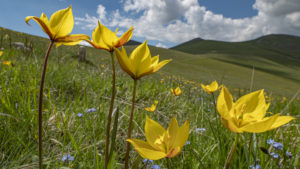
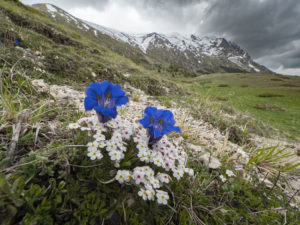
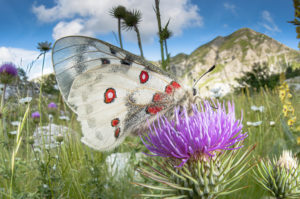
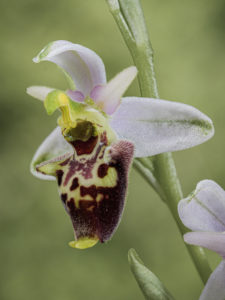

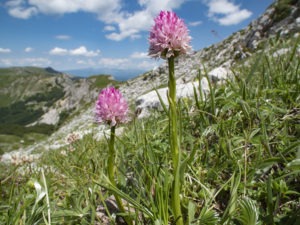
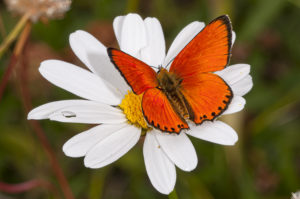
Day 1
Arrival in Rome and transfer to our base in the picturesque Campi valley (approx 2.5 hrs).
Day 2
In the morning we explore the fields and paths near Preci travelling along lanes and through traditionally managed meadows and woods where some orchid species thrive – to say nothing of an assortment of butterflies and birds such as hoopoe, nightjar, cirl bunting and scops owl. We travel a short distance to picnic and wander in an orchid-rich meadow high above the valley. After lunch, we explore parts of a local mountain with flower-strewn slopes and views over the Sibillini area to the distant snow-capped slopes of Mte Vettore beyond.
Day 3
We explore the woods and meadows along and above the Campi valley travelling up to several hill top villages in a leisurely fashion with numerous stops for flowers along the way. Then we head up to high pastures further west where butterflies abound and skylarks, quail and red-backed shrike compete for attention.
Day 4
We transfer to Castelluccio di Norcia (possibly Norcia itself depending on accommodation being open) where the first sight of the vast plain of the Piano Grande, is an unforgettable experience… especially just before the morning mist disperses from the ‘bowl’ ringed by mountains. We descend to the plain stopping for wild tulips and narcissus then travel to wards Monte Vettore where we picnic amongst the peonies and wander along easy paths.
Day 5
Piano Grande….With appetites whetted, we explore the hills ringing the plain looking for the best displays of flowers we can find as camera subjects – each year they change as fields are tilled. We make use of the low angle and warmth of the evening light to get those poppy and cornflower shots to remember.
Day 6
Our transfer takes us via mountain roads and spectacular scenery with frequent stops for roadside flowers…orchids include: sword-leaved helleborine (Cephalanthera longifolia), violet limodore (Limodorum abortivum) and bird’s nest orchid (Neottia nidus–avis)…in several places there are interesting butterflies such as Black-veined whites. and a range of ‘blues’. An afternoon visit to Mte Terminillo follows to get an idea of the Terrain and its richness.
Day 7
Our base allows us to reach the heights of Monte Terminillo travelling through dense beech woodlands to the heights beyond. Scenically, the limestone crags give the impression of a mini-Dolomite range. This is a true alpine realm where the short turf is studded with gentians (G. Verna and G. dinarica), Androsaces (rock jasmines), colourful pansies and spring crocus (Crocus verna) near the edges of patches of melting snow… Orchids include the distinct colour forms of elderflower orchid (Dactylorhiza sambucina) as well as pale-flowered orchid (Orchis pallens). This is perfect for those glorious flowers in the landscape shots…
Day 8
Return to Rome and the flights home
NB
Our time in and around the Piano Grande and Terminillo has to be a moveable feast – we literally keep a ‘weather eye’ open in this complex mountain system and rejig journeys according to local conditions to make sure we see as much as possible. For example, snow damage in winter can result in some closed roads but we know the area intimately and have alternatives…
The Piano Grande and surroundings are probably the jewel in the crown of our Sibillini tour. However, during a 2017 visit all access was closed because of the severe earthquake damage the previous August when villages and towns were decimated and roads destroyed. We did some quick thinking and had to change accommodation arranging to stay for two nights to give us access to Monte Terminillo and the high alpine pastures…It worked well and we have now incorporated this area into the tour as well as the Piano Grande because it expands the diversity of habitats and species seen. The pace of the week is relaxed with a modest amount of gentle ambling to get us to the best spots.
2023 “This was a delightful holiday amongst the mountains of Umbria. The Sibillini National Park is a varied and beautiful area with a wealth of wildlife and flora. Guiding, accommodation and travel was well-planned and comfortable, as I have come to expect with Greenwings.” Bob M.


